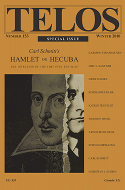By Charles Kollmer · Thursday, January 19, 2012 As an occasional feature on TELOSscope, we highlight a past Telos article whose critical insights continue to illuminate our thinking and challenge our assumptions. Today, Charles Kollmer looks at Stephanie Frank’s “Re-imagining the Public Sphere: Malebranche, Schmitt’s Hamlet, and the Lost Theater of Sovereignty,” from Telos 153 (Winter 2010).

In “Re-imagining the Public Sphere: Malebranche, Schmitt’s Hamlet, and the Lost Theater of Sovereignty,” Stephanie Frank outlines a compelling approach to Carl Schmitt’s complex oeuvre. She sets out to rectify a common mistake made in existing treatments of Schmitt; in studies of Schmitt’s early work Roman Catholicism and Political Form (1923), scholars tend to rely on a later work, Constitutional Theory (1928), as an explanatory crutch. Both texts model representation, but a conflation of their respective models obscures how Schmitt’s project changes between the works. As a corrective, Frank traces the nuances of Roman Catholicism‘s model back to the influence of seventeenth-century theologian Malebranche, who in turn influenced the eighteenth-century revolutionary Abbé Sieyès. By grounding Roman Catholicism in this historical context, Frank not only sidesteps the circularity of her colleagues’ interpretations but also lays the groundwork for a persuasive reading of Schmitt’s turn to aesthetics in Hamlet or Hecuba (1956).
Continue reading →
By Telos Press · Thursday, January 13, 2011 Drew Daniel’s “‘Neither Simple Allusions Nor True Mirrorings’: Seeing Double with Carl Schmitt” appears in Telos 153 (Winter 2010). Read the full version at TELOS Online website.
 In response to recent criticisms of Schmitt’s argument as “tendentious” and symptomatic, this essay seeks to perform a reparative reading of the central claim of Hamlet or Hecuba for a substantial resemblance between the events within Shakespeare’s play and the murky circumstances surrounding the death of King James’s father, Lord Darnley. First, the historical archive surrounding Lord Darnley’s death is sounded for evidence that might support Schmitt’s claim and illuminate unresolved questions within the plot of Hamlet (in particular, the mysterious “sins” referred to by the Ghost). Secondly, the archive of James’s own published writings on sovereignty, demonology, and witchcraft are placed into relation with Jean Bodin’s similar writings, and brought to bear upon Schmitt’s reading of Shakespeare’s ghost scenes. The cruxes within Shakespeare’s play and Schmitt’s text about the ghost scene (“spirit of health” or “goblin damned”? Catholic or Protestant?) illuminate the relationship between sovereignty and demonology in early modern England: the two discourses are linked by the attempt to establish the divine status of sovereignty and the corresponding subordination of demons and ghosts to theologically established limits and laws. Departing from Schmitt’s initial arguments, this essay extends them in order to illuminate the political-theological terrain within which Hamlet functions. In response to recent criticisms of Schmitt’s argument as “tendentious” and symptomatic, this essay seeks to perform a reparative reading of the central claim of Hamlet or Hecuba for a substantial resemblance between the events within Shakespeare’s play and the murky circumstances surrounding the death of King James’s father, Lord Darnley. First, the historical archive surrounding Lord Darnley’s death is sounded for evidence that might support Schmitt’s claim and illuminate unresolved questions within the plot of Hamlet (in particular, the mysterious “sins” referred to by the Ghost). Secondly, the archive of James’s own published writings on sovereignty, demonology, and witchcraft are placed into relation with Jean Bodin’s similar writings, and brought to bear upon Schmitt’s reading of Shakespeare’s ghost scenes. The cruxes within Shakespeare’s play and Schmitt’s text about the ghost scene (“spirit of health” or “goblin damned”? Catholic or Protestant?) illuminate the relationship between sovereignty and demonology in early modern England: the two discourses are linked by the attempt to establish the divine status of sovereignty and the corresponding subordination of demons and ghosts to theologically established limits and laws. Departing from Schmitt’s initial arguments, this essay extends them in order to illuminate the political-theological terrain within which Hamlet functions.
Continue reading →
 If recent discussions of Schmitt in these pages have made a broad case for the centrality of culture for his thinking, the current issue both specifies and generalizes this approach. The specificity derives from our focus on one key text by Schmitt that is often passed over but is in fact crucial for understanding his work. The generality is a result of the breathtaking sweep of issues that this text opens up for the contributors to this issue: the relation of sovereignty to popular will, the ontological status of modernity, the role of myth in society, the representational structure of human existence, the relation of art and theology to the public sphere. These discussions take our understanding of Schmitt into new directions that draw out not just the aesthetic and cultural aspects of his thought, but also reveal the import of his methods for fundamental questions of epistemology and ontology. He arrives at such questions through the consideration of a single exemplary case: Shakespeare’s Hamlet. If recent discussions of Schmitt in these pages have made a broad case for the centrality of culture for his thinking, the current issue both specifies and generalizes this approach. The specificity derives from our focus on one key text by Schmitt that is often passed over but is in fact crucial for understanding his work. The generality is a result of the breathtaking sweep of issues that this text opens up for the contributors to this issue: the relation of sovereignty to popular will, the ontological status of modernity, the role of myth in society, the representational structure of human existence, the relation of art and theology to the public sphere. These discussions take our understanding of Schmitt into new directions that draw out not just the aesthetic and cultural aspects of his thought, but also reveal the import of his methods for fundamental questions of epistemology and ontology. He arrives at such questions through the consideration of a single exemplary case: Shakespeare’s Hamlet.
Continue reading →
|
|








